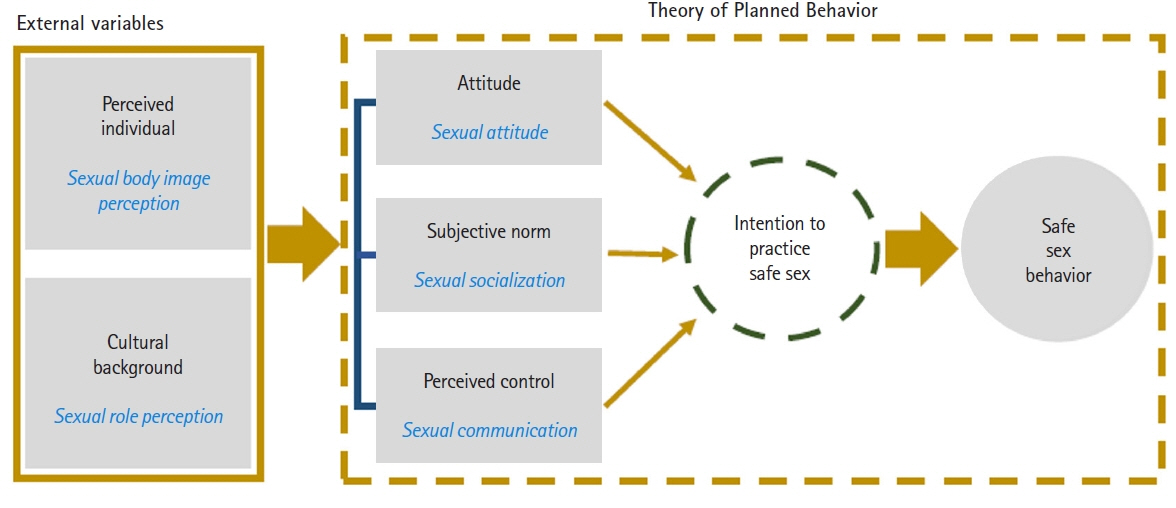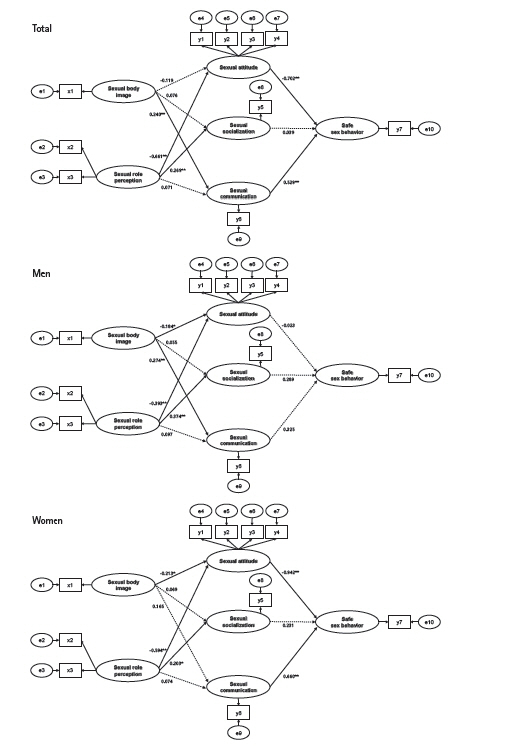Korean J Women Health Nurs.
2023 Jun;29(2):115-127. 10.4069/kjwhn.2023.06.16.
Factors affecting the safe sexual behaviors of Korean young adults by gender: a structural equation model
- Affiliations
-
- 1College of Nursing Science, Kyung Hee University, Seoul, Korea
- KMID: 2543810
- DOI: http://doi.org/10.4069/kjwhn.2023.06.16
Abstract
- Purpose
The aim of this study was to determine the factors that influence safe sexual behaviors of Korean young adults and identify differences by gender.
Methods
This study aimed to determine which factors affected safe sexual behaviors based on the Theory of Planned Behavior. Data from 437 Korean young adults (in their 20s and 30s) were collected via online survey between January 3 and January 28, 2022. The questionnaire included items on sexual body image, sexual role perception, sexual attitudes, sexual socialization, sexual communication, and safe sexual behaviors. Structural equation modeling was performed.
Results
According to the overall model fit of the hypothetical model, the final model was acceptable and explained 49% of safe sexual behaviors. Sexual attitudes (β=–.70, p<.001) and sexual communication (β=.53, p<.001) directly affected safe sexual behaviors, and sexual role perception (β=.42, p<.001) indirectly affected safe sexual behaviors in a combined model. There were gender differences in the path from sexual attitudes (β=–.94, p<.001) and sexual communication (β=.66, p<.001) to safe sexual behaviors and from sexual body image (β=.27, p<.001) to sexual communication.
Conclusion
Sexual attitudes and sexual communication were predictors of safe sexual behaviors, which differed by gender. Strategies that consider sexual attitudes, sexual communication, sexual role perception, and differences between men and women should be developed to improve the safe sexual behaviors of young adults.
Figure
Reference
-
References
1. World Health Organization. Sexually transmitted infections (STIs) [Internet]. Geneva: Author;2022. [cited 2022 Aug 22]. Available from: https://www.who.int/news-room/fact-sheets/detail/sexually-transmitted-infections-(stis).2. Centers for Disease Control and Prevention. Sexually transmitted disease surveillance 2020 [Internet]. Atlanta, GA: Author;2022. [cited 2022 Aug 22]. Available from: https://stacks.cdc.gov/view/cdc/125947.3. Holway GV, Brewster KL, Tillman KH. Condom use at first vaginal intercourse among adolescents and young adults in the United States, 2002-2017. J Adolesc Health. 2020; 67(4):606–608. https://doi.org/10.1016/j.jadohealth.2020.03.034.
Article4. Korean Statistical Information Service. Korean Social Trends 2022 [Internet]. Cheongju (Korea): Author;2022. [cited 2023 Apr 18]. Available from: https://sri.kostat.go.kr/menu.es?mid=a90104010100.5. Korean Disease Control and Prevention Agency. Annual report on the notified HIV/AIDS in Korea, 2021 [Internet]. Cheongju (Korea): Author;2021. [cited 2023 Apr 18]. Available from: https://npt.kdca.go.kr/npt/biz/npp/portal/nppPblctDtaView.do?pblctDtaSeAt=1&pblctDtaSn=2645.6. Gillen MM, Lefkowitz ES, Shearer CL. Does body image play a role in risky sexual behavior and attitudes? J Youth Adolesc. 2006; 35(2):230–42. https://doi.org/10.1007/s10964-005-9005-6.
Article7. Lefkowitz ES, Shearer CL, Gillen MM, Espinosa-Hernandez G. How gendered attitudes relate to women’s and men’s sexual behaviors and beliefs. Sex Cult. 2014; 18(4):833–846. https://doi.org/10.1007/s12119-014-9225-6.
Article8. Boone TL, Lefkowitz ES. Safer sex and the health belief model: considering the contributions of peer norms and socialization factors. J Psychol Human Sex. 2004; 16(1):51–68. https://doi.org/10.1300/J056v16n01_04.
Article9. Lou JH, Chen SH. Relationships among sexual knowledge, sexual attitudes, and safe sex behaviour among adolescents: a structural equation model. Int J Nurs Stud. 2009; 46(12):1595–1603. https://doi.org/10.1016/j.ijnurstu.2009.05.017.
Article10. Leija SG. Sexual socialization: a qualitative exploration of immigrant Latina mothers’ perception of sex-communication with their adolescent daughters. East Lansing, CA: Michigan State University;2022.11. Li Y, Samp JA. Sexual relationship power, safer sexual communication, and condom use: a comparison of heterosexual young men and women. West J Commun. 2017; 83(1):58–74. https://doi.org/10.1080/10570314.2017.1398835.
Article12. Flores D, Barroso J. 21st century parent-child sex communication in the United States: a process review. J Sex Res. 2017; 54(4-5):532–548. https://doi.org/10.1080/00224499.2016.1267693.
Article13. Widman L, Choukas-Bradley S, Noar SM, Nesi J, Garrett K. Parent-adolescent sexual communication and adolescent safer sex behavior: a meta-analysis. JAMA Pediatr. 2016; 170(1):52–61. https://doi.org/10.1001/jamapediatrics.2015.2731.
Article14. Kuhl J, Beckmann J, Ajzen I, Kruglanski AW, Klar Y, Gollwitzer PM. Action control form cognition to behavior. 1st ed. Berlin: Springer-Verlag;1985. p. 11–39.15. Ajzen I. The theory of planned behavior. Organ Behav Hum Decis Process. 1991; 50(2):179–211. https://doi.org/10.1016/0749-5978(91)90020-T.
Article16. Brookes E. The theory of planned behavior: behavioral intention [Internet]. Simply Psychology official portal. London: Simply Scholar;2021. [cited 2021 Jul 1]. Available from: https://www.simplypsychology.org/theory-of-planned-behavior.html.17. Tseng YH, Cheng CP, Kuo SH, Hou WL, Chan TF, Chou FH. Safe sexual behaviors intention among female youth: the construction on extended theory of planned behavior. J Adv Nurs. 2020; 76(3):814–823. https://doi.org/10.1111/jan.14277.
Article18. Wang X, Jin Y, Tian M, Zhuo Q, Lin CL, Hu P, et al. Safe-sex behavioral intention of Chinese college students: examining the effect of sexual knowledge using the theory of planned behavior. Front Psychol. 2022; 13:805371. https://doi.org/10.3389/fpsyg.2022.805371.
Article19. Moeini B, Hazavehei SM, Zareban I, Mousali A, Bashiriyan S, Soltanian AR, et al. Effectiveness of an educational program based on the theory of planned behavior for improving safe sexual behaviors intention among addicted males: a quasi experimental study. Int J High Risk Behav Addict. 2017; 6(2):e32432. https://doi.org/10.5812/ijhrba.32432.
Article20. Je M, Ju HO, Lee J. Factors affecting reproductive health promotion behavior among late-adolescent girls in South Korea: a cross-sectional descriptive study. Child Youth Serv Rev. 2020; 118:105347. https://doi.org/10.1016/j.childyouth.2020.105347.
Article21. Lin CL, Ye Y, Lin P, Lai XL, Jin YQ, Wang X, et al. Safe sexual behavior intentions among college students: the construction of an extended theory of planned behavior. Int J Environ Res Public Health. 2021; 18(12):6349. https://doi.org/10.3390/ijerph18126349.
Article22. Hwang SW, Chung CW. Structural equation modeling on contraception behavior of unmarried men and women in Korea: gender difference. J Korean Acad Nurs. 2014; 44(2):159–169. https://doi.org/10.4040/jkan.2014.44.2.159.
Article23. Kim YJ. A predictive model for safer sexual behavior among Korean university students: based on the theory of planned behavior [dissertation]. Seoul: Yonsei University;2014. 102.24. Yu JP. The concept and understanding of structural equation modeling. Seoul: Hannare Publishing;2012.25. Hair JF, Black WC, Babin BJ, Anderson RE, Tatham RL. Multivariate data analysis. 6th ed. Upper Saddle River, NJ: Pearson Prentice Hall;2006.26. DeVellis RF. Scale developemnt: theory and application. Los Angeles, CA: SAGE Publications;2017.27. DiIorio C, Parsons M, Lehr S, Adame D, Carlone J. Measurement of safe sex behavior in adolescents and young adults. Nurs Res. 1992; 41(4):203–208.28. Hendrick C, Hendrick SS, Reich DA. The brief sexual attitudes scale. J Sex Res. 2006; 43(1):76–86. https://doi.org/10.1080/00224490609552301.
Article29. Lottes IL, Kuriloff PJ. Sexual socialization differences by gender, Greek membership, ethnicity, and religious background. Psychol Women Q. 1994; 18(2):203–219. https://doi.org/10.1111/j.1471-6402.1994.tb00451.x.
Article30. Catania JA. Help-seeking: an avenue for adult sexual development. San Francisco, CA: University of California;1987.31. Bauer GR, Hammond R. Toward a broader conceptualization of trans women’s sexual health. Can J Hum Sex. 2015; 24(1):1–11. https://doi.org/10.3138/cjhs.24.1-CO1.
Article32. Caron SL, Davis CM, Halteman WA, Stickle M. Predictors of condom‐related behaviors among first‐year college students. J Sex Res. 1993; 30(3):252–259. https://doi.org/10.1080/00224499309551709.
Article33. Guan M. Sexual and reproductive health knowledge, sexual attitudes, and sexual behaviour of university students: findings of a Beijing-based survey in 2010-2011. Arch Public Health. 2021; 79(1):215. https://doi.org/10.1186/s13690-021-00739-5.
Article34. Imo CK, Odimegwu CO, De Wet-Billings N. Women’s attitudes towards negotiating safe sexual practices in Nigeria: do family structure and decision-making autonomy play a role? BMC Womens Health. 2022; 22(1):16. https://doi.org/10.1186/s12905-022-01602-7.
Article35. Yang XH, Yuan S, Zhang R, Yu JF, Nzala SH, Wang PG, et al. Risky sexual behaviors and associated factors among college students in Lusaka, Zambia. Arch Sex Behav. 2019; 48(7):2117–2123. https://doi.org/10.1007/s10508-019-1442-5.
Article36. Widman L, Noar SM, Choukas-Bradley S, Francis DB. Adolescent sexual health communication and condom use: a meta-analysis. Health Psychol. 2014; 33(10):1113–1124. https://doi.org/10.1037/hea0000112.
Article37. Namisi FS, Aarø LE, Kaaya S, Onya HE, Wubs A, Mathews C. Condom use and sexuality communication with adults: a study among high school students in South Africa and Tanzania. BMC Public Health. 2013; 13:874. https://doi.org/10.1186/1471-2458-13-874.
Article38. Rogers AA. Parent–adolescent sexual communication and adolescents’ sexual behaviors: a conceptual model and systematic review. Adolesc Res Rev. 2016; 2(4):293–313. https://doi.org/10.1007/s40894-016-0049-5.
Article39. Gause NK, Brown JL, Welge J, Northern N. Meta-analyses of HIV prevention interventions targeting improved partner communication: effects on partner communication and condom use frequency outcomes. J Behav Med. 2018; 41(4):423–440. https://doi.org/10.1007/s10865-018-9916-9.
Article40. Zuo X, Lou C, Gao E, Cheng Y, Niu H, Zabin LS. Gender differences in adolescent premarital sexual permissiveness in three Asian cities: effects of gender-role attitudes. J Adolesc Health. 2012; 50(3 Suppl):S18–S25. https://doi.org/10.1016/j.jadohealth.2011.12.001.
Article41. Gillen MM, Markey CH. A review of research linking body image and sexual well-being. Body Image. 2019; 31:294–301. https://doi.org/10.1016/j.bodyim.2018.12.004.
Article42. Gillen MM, Markey CN. Body image and HIV risk among college students. Am J Health Behav. 2014; 38(6):816–822. https://doi.org/10.5993/AJHB.38.6.3.
Article43. Ramseyer Winter V, Gillen MM, Kennedy AK. Associations between body appreciation and comfort communicating about sex: a brief report. Health Commun. 2018; 33(3):359–362. https://doi.org/10.1080/10410236.2016.1255845.
Article44. Wright PJ, Herbenick D, Paul B. Adolescent condom use, parent-adolescent sexual health communication, and pornography: findings from a U.S. probability sample. Health Commun. 2020; 35(13):1576–1582. https://doi.org/10.1080/10410236.2019.1652392.
Article45. Wu T, Zheng Y. Effect of sexual esteem and sexual communication on the relationship between body image and sexual function in Chinese heterosexual women. J Sex Med. 2021; 18(3):474–486. https://doi.org/10.1016/j.jsxm.2020.12.006.46. Davison TE, McCabe MP. Relationships between men’s and women’s body image and their psychological, social, and sexual functioning. Sex Roles. 2005; 52(7-8):463–475. https://doi.org/10.1007/s11199-005-3712-z.47. Ahrold TK, Meston CM. Ethnic differences in sexual attitudes of U.S. college students: gender, acculturation, and religiosity factors. Arch Sex Behav. 2010; 39(1):190–202. https://doi.org/10.1007/s10508-008-9406-1.48. Lyu J, Shen X, Hesketh T. Sexual Knowledge, Attitudes and behaviours among undergraduate students in China-implications for sex education. Int J Environ Res Public Health. 2020; 17(18):6716. https://doi.org/10.3390/ijerph17186716.49. Valente AM, Auerswald CL. Gender differences in sexual risk and sexually transmitted infections correlate with gender differences in social networks among San Francisco homeless youth. J Adolesc Health. 2013; 53(4):486–491. https://doi.org/10.1016/j.jadohealth.2013.05.016.50. Muñoz-Silva A, Sánchez-García M, Martins A, Cristina N. Gender differences in HIV-related sexual behavior among college students from Spain and Portugal. Span J Psychol. 2009; 12(2):485–495. https://doi.org/10.1017/s1138741600001864.51. Martin JC, Mak JY. College students’ sexual knowledge and attitudes. KAHPERD J. 2013; 51(1):16–25.52. Ackard DM, Kearney-Cooke A, Peterson CB. Effect of body image and self-image on women's sexual behaviors. Int J Eat Disord. 2000; 28(4):422–429. https://doi.org/10.1002/1098-108x(200012)28:4<422::aid-eat10>3.0.co;2-1.
Article53. La Rocque CL, Cioe J. An evaluation of the relationship between body image and sexual avoidance. J Sex Res. 2011; 48(4):397–408. https://doi.org/10.1080/00224499.2010.499522.
Article
- Full Text Links
- Actions
-
Cited
- CITED
-
- Close
- Share
- Similar articles
-
- A Structural Equation Model on Sexual Function in Women with Gynecologic Cancer
- Structural relations of late night snacking choice attributes and health promotion behaviors according to dietary style of industrial workers
- Association between Eating Alone and Metabolic Syndrome: A Structural Equation Modeling Approach
- Model Construction of Sexual Satisfaction in Patients with a Colostomy
- Relationship between Sex Role Identity Type, Sexual Consciousness, Sexual Behaviors and Sexual Impulse of University Students



